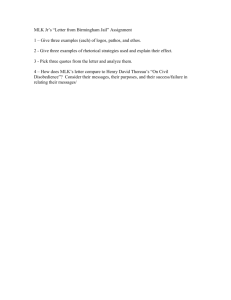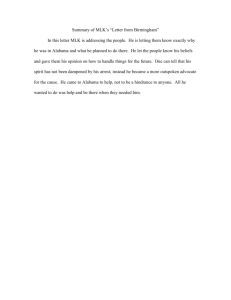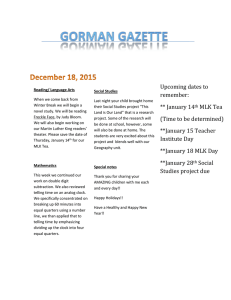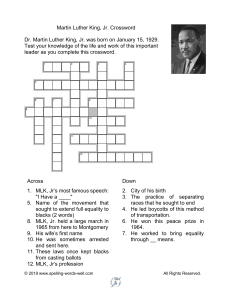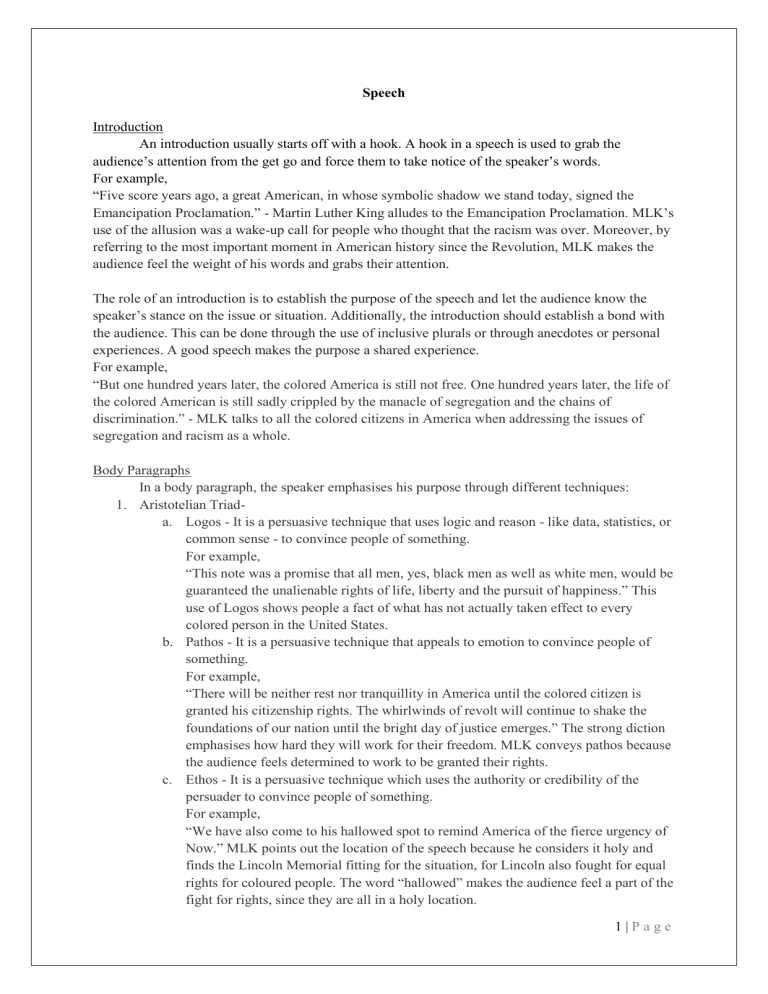
Speech Introduction An introduction usually starts off with a hook. A hook in a speech is used to grab the audience’s attention from the get go and force them to take notice of the speaker’s words. For example, “Five score years ago, a great American, in whose symbolic shadow we stand today, signed the Emancipation Proclamation.” - Martin Luther King alludes to the Emancipation Proclamation. MLK’s use of the allusion was a wake-up call for people who thought that the racism was over. Moreover, by referring to the most important moment in American history since the Revolution, MLK makes the audience feel the weight of his words and grabs their attention. The role of an introduction is to establish the purpose of the speech and let the audience know the speaker’s stance on the issue or situation. Additionally, the introduction should establish a bond with the audience. This can be done through the use of inclusive plurals or through anecdotes or personal experiences. A good speech makes the purpose a shared experience. For example, “But one hundred years later, the colored America is still not free. One hundred years later, the life of the colored American is still sadly crippled by the manacle of segregation and the chains of discrimination.” - MLK talks to all the colored citizens in America when addressing the issues of segregation and racism as a whole. Body Paragraphs In a body paragraph, the speaker emphasises his purpose through different techniques: 1. Aristotelian Triada. Logos - It is a persuasive technique that uses logic and reason - like data, statistics, or common sense - to convince people of something. For example, “This note was a promise that all men, yes, black men as well as white men, would be guaranteed the unalienable rights of life, liberty and the pursuit of happiness.” This use of Logos shows people a fact of what has not actually taken effect to every colored person in the United States. b. Pathos - It is a persuasive technique that appeals to emotion to convince people of something. For example, “There will be neither rest nor tranquillity in America until the colored citizen is granted his citizenship rights. The whirlwinds of revolt will continue to shake the foundations of our nation until the bright day of justice emerges.” The strong diction emphasises how hard they will work for their freedom. MLK conveys pathos because the audience feels determined to work to be granted their rights. c. Ethos - It is a persuasive technique which uses the authority or credibility of the persuader to convince people of something. For example, “We have also come to his hallowed spot to remind America of the fierce urgency of Now.” MLK points out the location of the speech because he considers it holy and finds the Lincoln Memorial fitting for the situation, for Lincoln also fought for equal rights for coloured people. The word “hallowed” makes the audience feel a part of the fight for rights, since they are all in a holy location. 1|Page 2. Anecdotes - An anecdote is a short story, commonly amusing or thought provoking in nature, about some sort of event or person. Anecdotes are used to convey a message and provide the correct example in the message. For example, “In 1964 I was a little girl sitting on the linoleum floor of my mother’s house in Milwaukee watching Anne Bancroft present the Oscar for best actor at the 36th Academy Awards. She opened the envelope and said five words that literally made history, “The winner is Sidney Poitier.” Up to the stage came the most elegant man I had ever seen. I remember his tie was white, of course his skin was black, and I had never seen a black man being celebrated like that. And I have tried many, many times to explain what a moment like that means to a little girl, a kid watching from the cheap seats, as my mom came through the door bone tired from cleaning other people’s houses.” This is a story shared by Oprah Winfrey in her powerful speech at the 2018 Golden Globes. This story sets up the first theme of the speech: the responsibility actresses have as role models of the little girls watching and idolising them. 3. Allusions - It is a literary device that refers to a famous person, group, historical event, place or work of art. They are mainly used to create associations with the message the speaker is trying to convey. You can refer back to the hook of the MLK speech for an example. 4. Figurative Language - It uses figures of speech such as similes and metaphors to crystallise an abstract idea. The speaker strengthens his idea by implying them. For example, “a state sweltering with the heat of oppression” MLK compares the discrimination in Mississippi to “heat of oppression”. This defines discrimination to be uncomfortable and harmful for the colored people in Mississippi and strengthens MLK’s message. 5. Hypophora - It is a literary device in which the speaker raises a question, and then immediately provides an answer to that question. Its main purpose is to enable the speaker to anticipate the listeners’ concerns and then address them within the context of his own speech. For example, “There are those who are asking the devotees of civil rights, “When will you be satisfied?” We can never be satisfied as long as the Negro is the victim of the unspeakable horrors of police brutality.” MLK is clearly providing his stance on civil rights. And he shows the audience that he will not be satisfied until the colored America is treated equally. 6. Anaphora - It is a figure of speech in which words repeat at the beginning of successive clauses, phrases or sentences. For example, “One hundred years later, the life of the colored American is still sadly crippled by the manacle of segregation and the chains of discrimination. One hundred years later, the colored American lives on a lonely island of poverty in the midst of a vast ocean of material prosperity.” MLK describes how things are for African Americans long after the Emancipation Proclamation. The anaphora drives home the message that progress has been slow over a very long time. 7. Parallelism or Parallel Structure - When a speaker repeats the same grammatical unit/syntax the same word, phrase, sentence structure, or even paragraph structure - they are employing parallel structure. For example, “I have a dream that one day this nation will rise up and live out the true meaning of its creed. We hold these truths to be self-evident that all men are created equal. I have a dream that one day out in the red hills of Georgia the sons of former slaves and the sons of former slave 2|Page owners will be able to sit down together at the table of brotherhood. I have a dream that one day even the state of Mississippi, a state sweltering with the heat of oppression, will be transformed into an oasis of freedom and justice.” For six paragraphs in a row, he describes a vision of racial unity between descendants of slaves and slave-owners - a revolution of tolerance. The repetition of “I have a dream” lets the theme of MLK’s vision sink into the audience’s mind. 8. Tricolon - It is a rhetorical device that consists of three parallel clauses, phrases, or words, which happen to come in quick succession without any interruption. For example, “black men and white men, Jews and Gentiles, Protestants and Catholics” MLK uses the tricolon to cover the total scope of “God’s children”. The tricolon helps MLK achieve a sense of totality and gets the whole crowd involved in his movement. 9. Asyndeton - It is a stylistic device where a speaker omits conjunctions. For example, “With this faith we will be able to work together, to pray together, to struggle together, to go to jail together, to stand up for freedom together, knowing that we will be free one day.” MLK makes use of the asyndeton to express a bigger set of ideas to concisely convey the message to the audience. Throughout the body of the speech, the speaker repeats the purpose using different rhetorical devices and provides the benefits of the purpose using appeals. The speaker must also clarify a destination of the speech in the beginning to make sure that the audience knows how the speech will evolve. There should be a reason for the people to listen. This is where the construction of sentences (long winding sentences or short punchy ones) comes into play along with the way the speech is delivered (the timing, pauses and nuances). Conclusion The most important aspect of a conclusion in a speech is the call to action (CTA). CTA comes right before the end of a persuasive speech, and it is used to clearly tell the audience the role they can play after they leave the speaker’s talk. For example, By asking the audience to “let freedom ring” MLK asks them to keep fighting for their rights until they get them. The speech should end with a concluding message and a finality. For example, “Free at last, free at last. Thank God Almighty, we are free at last” MLK alludes to the African American Spiritual and Gospel song “Free at last” to let the audience know what the result of their fight would be, motivating the audience to join MLK in his crusade. 3|Page
